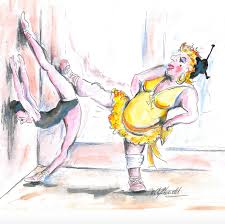Strength Beats Stretch
We would love our students and parents to read this..
POSTED ON 16 APRIL 2018 BY ROSE MULREADY https://australianballet.com.au/behind-ballet/strength-beats-stretch?fbclid=IwAR2dI-TYc_9vEbczm5t-WVoNrLddA1GyqOaBPunKkZtpaovpOXoxks_tlmI
The Australian Ballet’s medical team is educating the company’s dancers about the dangers of stretching. Counter-intuitive? Read on.
Willowy dancers melting over their legs, their noses to their knees, or sitting improbably in the splits to darn their pointe shoes: these are quintessential ballet images. So it may come as a surprise that Sue Mayes, the company’s principal physiotherapist, winces at the thought.
In the early 2000s, Mayes and her team started focusing on the ankles and calves, common injury sites for dancers. They found that dancers prone to these injuries usually had poor calf endurance, so they introduced a program of calf rises (standing on one leg and moving between demi-pointe and a flat foot) into daily class. Strengthening the calf proved stunningly effective in reducing ankle injuries and calf tears; but that was only part of the picture.
“The other part of the program was educating the dancers not to stretch their calves,” says Mayes. “There used to be stretching boards in every studio, and the dancers would stretch their calves before, after and even during class and rehearsal. We took those boards out of the studios and encouraged the dancers to use the muscles’ strength to lengthen out.”
Conventional ballet wisdom has it that stretching produces long, elegant muscles, whereas strengthening makes them bulky. For the dancers, Mayes’ message – stretch less, strengthen more, don’t hang out in stretched positions – was a hard sell. It wasn’t until they saw a core group of dancers working over long periods with the team’s strengthening program, and saw they retained their balletic lines, that they were able to accept it wouldn’t make them bulge.
It’s all in the way you strengthen. To build the Popeye muscle beloved of a certain kind of gym bunny, you need high load and lots of repetitions. The dancers work with both a strength model (high load, low repetitions) and an endurance model (low load, lots of repetitions). The combination gives them muscles that can support and protect their joints as they move through the extreme ranges of motion required by ballet.
Fear of bulking up wasn’t the only reason for the dancers’ resistance to the stretch-reduction message. Stretching feels good, particularly to a body battered by the demands of a professional dance career. However, Mayes says, that’s no reason to do it. “Just because it feels good, doesn’t mean it’s good for you. Take eating sugar: it feels great! When you stretch out a pinched-up, angry bit of tissue, it feels nice, but you’re just perpetuating the problem, because you’re stretching and weakening something that is already loose and needs to be strengthened. You’re scratching the itch, but not fixing the cause, like scratching a mosquito bite – you’re just making it worse.”
Having established that strengthening helped prevent muscle tearing in the calf, and that stretching could weaken it, making it prone to tears and reducing its propulsive power, Mayes’ team started to apply that knowledge to all the muscles in the body. “The muscles that dancers love to stretch are the hamstrings and the adductors (in the inner thighs). They love to sit in the splits. However, there’s a lot of recent sports research that supports our clinical impression, which is that static stretching – staying in a stretch for a long period of time, without using the muscle – can actually be damaging.” Mayes points to the sprinters in the 2016 Olympics. “You used to see sprinters stretching their hamstrings before the race. And almost inevitably, one of them would tear a hamstring during it. In the most recent Olympics you saw them doing dynamic warm-ups, jogging, keeping their body warm – they’d probably done some strengthening and dynamic stretching quite a while before the race, so immediately pre-race it’s about keeping their heart rate up, all their muscles warm and their body active, but without any extreme range of movement.”
So should ballet dancers abandon stretching altogether? Mayes emphasises that it’s all in the way you do it. “A good warm-up before class is to take the muscle through its range dynamically, rather than to sit in a stretch. For instance, you could do a slow, controlled cloche (where the leg swings like the clapper of a bell), using the muscle to decelerate.”
Before morning class, most of the company’s dancers spend some time in the gym gently strengthening all their muscles, waking them up and readying them for ballet moves. They’ll take the muscle to the extreme edge of a movement, but in a slow, controlled way, and then gradually increase the speed until the body temperature is up and the muscles feel warm and elastic.
“Class is a really lovely progression from that,” says Mayes. “It starts slow and small and builds to the more extreme ranges. Even the jumps start small and progress. Ballet class is a beautiful way to build the body towards the challenging repertoire of a professional dancer.”
For amateur ballet dancers, who can’t easily slip into a gym before class, Mayes’ solution is simple. “Try a gentle jog around the studio. A lot of our dancers ride their bikes into work before morning class. Anything that increases the body temperature and gets the blood flowing. Then you might try little exercises to wake up the body – areas like the hip, trunk, calf.”
Sports hobbyists may like to take note of the advice Mayes and her team give to the company dancers who enjoy jogging and yoga. “The key injuries for runners are calf tears and Achilles tendinopathy (where a tendon is not coping with the load on it). Tendons hate surprises, so avoid suddenly increasing the load – for instance, you wouldn’t want to abruptly start running with no preparation. It’s very aggravating for tendons to be stretched, so our advice to dancers who run is to cut out the pre-run stretches and get the calf capacity up with something like single-leg calf rises: 25 on each leg, at least. Dancers aim for about 35, but everyone’s very individual. Jasmin Durham, one of our dancers, can do 100 beautiful, perfect calf rises.”
As to the warm-down stretch, “the evidence suggests that there is no benefit to it. A gentle jog, slowing down your heart rate gradually, will be more effective. If you’re going to stretch, make it a dynamic stretch.” Mayes’ advice to the yogis among the dancers is similar: “Make sure that your muscles are engaged when you’re stretching. Avoid long static stretches, which can actually stretch the capsules of the joints and damage them.”
What about the general population – for instance, desk-bound office workers who have been told that regular stretching will relieve their lethargy and tension? Mayes would rather emphasise regular activity. “Don’t sit too long – try to move around as much as possible. Choose stairs instead of the lift. Jump up and do calf rises while you read. Walk wherever you can. Go up and down a few flights of stairs in your break.”
For dancers, the message is clear: strengthening the muscles is the safest and most effective road to flexibility. Like sugar, static stretching is a hard habit to break. But your joints will thank you.


Leave a Reply